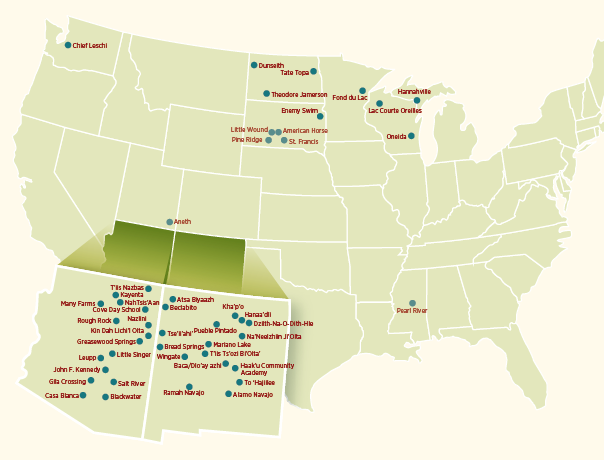Family and Child Education program celebrates 30 years
This year, the National Center for Families Learning (NCFL) and Bureau of Indian Education (BIE) celebrate 30 years of service and learning in the Family and Child Education (FACE) program. FACE, a program funded by the BIE, supports American Indian families and exists today across 48 programs in 10 states. Over the past 30 years, the family literacy program has engaged over 52,000 American Indians, including 24,000 adults and 19,000 children from approximately 23,000 families.
How did it all start? Thirty years ago, William (Bill) Mehojah, the director of the Bureau of Indian Affairs (BIA) at the time, identified the need for quality preschool and parent engagement programs. He met with Sharon Darling, president and founder of NCFL, who shared success stories of parents and children attending family literacy programs in Kentucky. Darling explained the important connection between families learning together and educational achievement. Mehojah recognized that to impact the educational attainment of American Indian children, programs must bridge the gap in learning and enhance the educational achievement of parents and primary caregivers.
“It dawned on me that there were so many similarities between what was going on with families in Appalachia and what was happening with families in Indian communities.”
– William Mehojah (Grit, Grace, & Gratitude: A 30-Year Journey, 2019)
Mehojah and Darling then met with Mildred Winters, the founder of Parents as Teachers National Center (PATNC), to explore PATNC’s existing programming for children from birth to grade three. Through their collaboration, the Family and Child Education (FACE) program was born.
FACE was designed to provide culturally and linguistically responsive education, resources, and support for American Indian families with children from birth to grade three. It provides a comprehensive early childhood family literacy program that includes home visiting, preschool education, adult education, and intensive parent engagement.
The goals of the FACE program are to:
- Support parents and primary caregivers in their role as their child’s first and most influential teacher.
- Strengthen family-school-community connections.
- Increase parent and primary caregiver participation in their child’s learning and expectations for academic achievement.
- Support and celebrate the unique cultural and linguistic diversity of each American Indian community served by the program.
- Promote school readiness and lifelong learning.

Consistent outcomes over the years include:
- Higher reading and math scores in elementary school.
- Significantly increased parent engagement in children’s learning.
- Children with learning differences are better prepared for kindergarten.
- Children significantly increase language development.
- Increased parent self-efficacy, education, and employment.
This year, despite the extraordinary circumstances facing schools due to the COVID-19 pandemic, the FACE sites have risen to the challenge, continuing to provide support for the families as well as preschool and adult education classes. By connecting through technology, at-home learning packets, and even meeting in cars in a parking lot, FACE sites used resources available to continue to provide services.
NCFL honors 30 years of FACE families and teachers working together toward success. We also celebrate the 30-year partnerships with the Bureau of Indian Education and Parents as Teachers National Center.
Congratulations, FACE! We look forward to another 30 years of strong programming through the efforts and leadership of all who work and serve families in the Family and Child Education program.
Read more from FACE participants over the years:
My journey at the Salt River FACE program
Two decades of the FACE program
Click here to listen to Bill Mehojah, former director of the Bureau of Indian Education, discuss the FACE program’s origins.